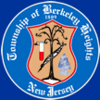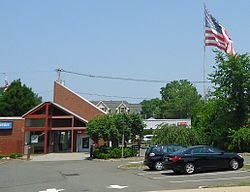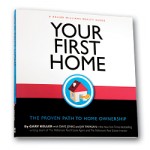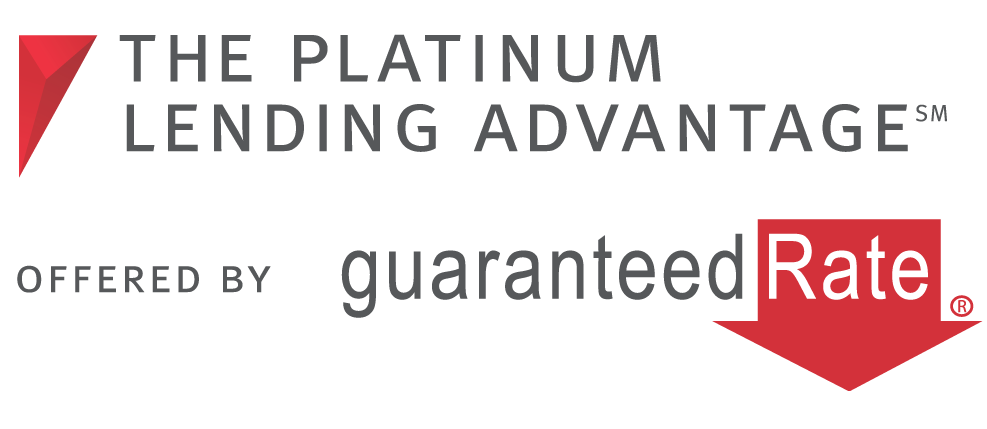Search homes in $300,000-500,000
$500,000-750,000
$750,000-1,000,000
$1,000,000+
Berkeley Heights, New Jersey
| Berkeley Heights, New Jersey | ||
|---|---|---|
| Township | ||
| Township of Berkeley Heights | ||
|
||
| Motto: "A Great Place to Live" | ||
| Map of Berkeley Heights in Union County. Inset: Location of Union County highlighted in the State of New Jersey. | ||
| Census Bureau map of Berkeley Heights, New Jersey | ||
| Coordinates: 40.676393°N 74.425027°WCoordinates: 40.676393°N 74.425027°W[1][2] | ||
| Country | United States | |
| State | New Jersey | |
| County | Union | |
| Incorporated | November 8, 1809 (asNew Providence Township) | |
| Renamed | November 6, 1951 (asBerkeley Heights Township) | |
| Government[6] | ||
| • Type | Faulkner Act (Mayor-Council-Administrator) | |
| • Mayor | Joseph G. Bruno (term ends December 31, 2014)[3] | |
| • Administrator | Linda Lordi Cavanaugh (as of June 2013)[4] | |
| • Clerk | Ana Minkoff [5] | |
| Area[2] | ||
| • Total | 6.266 sq mi (16.229 km2) | |
| • Land | 6.211 sq mi (16.087 km2) | |
| • Water | 0.055 sq mi (0.142 km2) 0.88% | |
| Area rank | 252nd of 566 in state 6th of 21 in county[2] |
|
| Elevation[7] | 394 ft (120 m) | |
| Population (2010 Census)[8][9][10][11] | ||
| • Total | 13,183 | |
| • Estimate (2012[12]) | 13,378 | |
| • Rank | 189th of 566 in state 15th of 21 in county[13] |
|
| • Density | 2,122.4/sq mi (819.5/km2) | |
| • Density rank | 283rd of 566 in state 20th of 21 in county[13] |
|
| Time zone | Eastern (EST) (UTC-5) | |
| • Summer (DST) | Eastern (EDT) (UTC-4) | |
| ZIP code | 07922[14][15] | |
| Area code(s) | 908 | |
| FIPS code | 3403905320[16][2][17] | |
| GNIS feature ID | 0882218[18][2] | |
| Website | Official site | |
Berkeley Heights is a township in Union County,New Jersey, United States. As of the 2010 United States Census, the township's population was 13,183,[8][9][10] reflecting a decline of 224 (-1.7%) from the 13,407 counted in the 2000 Census, which had in turn increased by 1,427 (+11.9%) from the 11,980 counted in the 1990 Census.[19]
Berkeley Heights was originally incorporated asNew Providence Township by the New Jersey Legislature on November 8, 1809, from portions ofSpringfield Township, while the area was still part of Essex County. New Providence Township became part of the newly formed Union County at its creation on March 19, 1857. Portions of the township were taken on March 23, 1869, to create Summit, and on March 14, 1899, to form the borough of New Providence. On November 6, 1951, the name of the township was changed toBerkeley Heights, based on the results of a referendum held that day.[20]
In Money magazine's 2013 Best Places to Live rankings, Berkeley Heights was ranked 6th in the nation, the highest among the three places in New Jersey included in the top 50 list.[21][22] The magazine's 2007 list had the township ranked 45th out of a potential 2,800 places in the United States with populations above 7,500 and under 50,000.[23]
In its 2010 rankings of the "Best Places to Live",New Jersey Monthly magazine ranked Berkeley Heights as the 19th best place to live in New Jersey.[24] In its 2008 rankings of the "Best Places To Live" New Jersey Monthly magazine ranked Berkeley Heights as the 59th best place to live in New Jersey.[25]
Geography[edit]
Berkeley Heights is located at40°40′35″N 74°25′30″W (40.676393,-74.425027). According to the United States Census Bureau, the township had a total area of 6.266 square miles (16.229 km2), of which, 6.211 square miles (16.087 km2) of it is land and 0.055 square miles (0.142 km2) of it (0.88%) is water.[1][2]
The township is located partially on the crest of the Second Watchung Mountain and in the Passaic River Valley, aptly named as thePassaic River forms the township's northern border. Berkeley Heights is located in northwestern Union County, at the confluence of Union, Morris, and Somerset Counties. Berkeley Heights is bordered by New Providence andSummit to the east, Scotch Plains to the southeast, Chatham to the north, Watchung to the south, and Warren Township and Long Hill Township to the west.
Downtown[edit]
Downtown Berkeley Heights is located along Springfield Avenue, approximately between the intersections with Plainfield Avenue and Snyder Avenue. In addition, a post office, the Municipal Building, police station, train station, Walgreens, Stop & Shop and other shops and services are located in this downtown section.
A brick walk with personalized bricks engraved with the names of many long-time Berkeley Heights residents runs from near the railroad station towards Kings grocery store. A memorial to the victims of the September 11, 2001 terrorist attacks adjoins a wooded area alongside Park Avenue, just southwest of downtown.
History[edit]
The Lenape Native Americans were known to inhabit the region, including the area now known as Berkeley Heights, dating back to the 1524 voyage of Giovanni da Verrazzano to what is now the lower New York Bay.
The earliest construction in Berkeley Heights began in an area that is now part of the 1,960 acres (7.93 km2) Watchung Reservation, a Union County park that includes 305 acres (1.234 km2) of the township.[26]
The first European settler was Peter Willcox, who received a 424 acres (1.716 km2) land grant in 1720 from the Elizabethtown Associates. This group bought much of northern New Jersey from the Lenape in the late 17th century. Willcox built a grist and lumber mill across Green Brook.[27]
In 1793, a regional government was formed. It encompassed the area from present-day Springfield Township, Summit, New Providence, and Berkeley Heights, and was called Springfield Township. Growth continued in the area, and by 1809, Springfield Township divided into Springfield Township and New Providence Township, which included present day Summit, New Providence, and Berkeley Heights.[20]
In 1845, Mr. Willcox's heirs sold the mill to David Felt, a paper manufacturer from New York. Felt built a small village around the mill aptly named Feltville. It included homes for workers and their families, dormitories, orchards, a post office and a general store with a second floor church.[27]
In 1860, Feltville was sold to sarsaparilla makers. Other manufacturing operations continued until Feltville went into bankruptcy in 1882. When residents moved away, the area became known as Deserted Village. Village remains consist of seven houses, a store, the mill and a barn. Deserted Village is listed on the National Register of Historic Places and is undergoing restoration by the Union County Parks Department. Restoration grants of almost $2 million were received from various state agencies.[28] Deserted Village, in the Watchung Reservation, is open daily for unguided walking tours during daylight hours.
On March 23, 1869, Summit Township (now the City of Summit) seceded from New Providence Township. On March 14, 1899, the Borough of New Providence seceded from New Providence Township. Present day Berkeley Heights remained as New Providence Township.[20] Many of the townships and regional areas in New Jersey were separating into small, locally governed communities at that time due to acts of the New Jersey Legislature that made it economically advantageous for the communities to due so.
Due to confusion between the adjacent municipalities of the Borough of New Providence and the Township of New Providence, the township conducted a referendum in 1952 and voted to change the name to Berkeley Heights Township. The origin of the township's name has never been fully established, but is believed to have been taken from an area of town that was referred to by this moniker, which itself was assumed to be derived from Lord John Berkeley, who was co-proprietor of New Jersey from 1664 to 1674.[29]
Early life in Berkeley Heights is documented in the Littell-Lord Farmhouse Museum & Farmstead (31 Horseshoe Road in Berkeley Heights), an 18-acre (73,000 m2) museum surrounding two houses, one of which was built in the 1750s and the other near the start of the 19th century.
Among the exhibits are a Victorian master bedroom and a Victorian children's room, furnished with period antiques. The children's room also has reproductions of antique toys, which visitors can play with. The museum, which is on the National Register of Historic Places, also includes an outbuilding that was used as a summer kitchen, a corncrib dating to the 19th century and a spring house built around a spring and used for refrigeration.[30] The museum is open 2-4 p.m. on the third Sunday of each month from April through December, or by appointment.
The township owes its rural character to its late development. Until 1941, when the American Telephone and Telegraph Company built the AT&T Bell Laboratories research facility in the township, it was a sleepy farming and resort community.[27]
Free Acres[edit]
Another early Berkeley Heights community of note is the 67-acre (271,000 m2) Free Acres, established in 1910 by Bolton Hall, a New York entrepreneur and reformer who believed in the idea of Henry George, the economist, of single taxation, under which residents pay tax to the community, which, in turn, pays a lump sum to the municipality. Among the early residents of Free Acres were the actor James Cagney and his wife, Billie.[27]
Residents of Free Acres pay tax to their association, which maintains its streets and swimming pool, approves architectural changes to homes and pays a lump sum in taxes to the municipality.[27]
Demographics[edit]
| Historical populations | |||
|---|---|---|---|
| Census | Pop. | %± | |
| 1810 | 756 | ||
| 1820 | 768 | 1.6% | |
| 1830 | 903 | 17.6% | |
| 1840 | 832 | −7.9% | |
| 1850 | 1,216 | 46.2% | |
| 1860 | 1,308 | 7.6% | |
| 1870 | 934 | * | −28.6% |
| 1880 | 781 | −16.4% | |
| 1890 | 839 | 7.4% | |
| 1900 | 469 | * | −44.1% |
| 1910 | 526 | 12.2% | |
| 1920 | 954 | 81.4% | |
| 1930 | 1,899 | 99.1% | |
| 1940 | 2,194 | 15.5% | |
| 1950 | 3,466 | 58.0% | |
| 1960 | 8,721 | 151.6% | |
| 1970 | 13,078 | 50.0% | |
| 1980 | 12,549 | −4.0% | |
| 1990 | 11,980 | −4.5% | |
| 2000 | 13,407 | 11.9% | |
| 2010 | 13,183 | −1.7% | |
| Est. 2012 | 13,378 | [12] | 1.5% |
| Population sources:1810-1920[31] 1840[32] 1850[33] 1860-1870[34] 1870[35] 1880-1890[36] 1890-1910[37] 1910-1930[38] 1930-1990[39] 2000[40][41] 2010[8][9][10] * = Lost territory in previous decade.[20] |
|||
2010 Census[edit]
At the 2010 United States Census, there were 13,183 people, 4,470 households, and 3,580 families residing in the township. The population density was 2,122.4 inhabitants per square mile (819.5 /km2). There were 4,596 housing units at an average density of 739.9 per square mile (285.7 /km2). The racial makeup of the township was 85.64% (11,290) White, 1.49% (197) Black or African American, 0.02% (3) Native American, 10.43% (1,375) Asian, 0.00% (0) Pacific Islander, 0.75% (99) from other races, and 1.66% (219) from two or more races.Hispanic or Latino of any race were 5.12% (675) of the population.[8]
There were 4,470 households of which 41.7% had children under the age of 18 living with them, 71.1% were married couples living together, 6.5% had a female householder with no husband present, and 19.9% were non-families. 17.6% of all households were made up of individuals and 10.4% had someone living alone who was 65 years of age or older. The average household size was 2.85 and the average family size was 3.26.[8]
In the township, 26.9% of the population were under the age of 18, 5.2% from 18 to 24, 20.5% from 25 to 44, 30.0% from 45 to 64, and 17.5% who were 65 years of age or older. The median age was 43.5 years. For every 100 females there were 90.6 males. For every 100 females age 18 and over, there were 87.5 males.[8]
The Census Bureau's 2006-2010 American Community Surveyshowed that (in 2010 inflation-adjusted dollars) median household income was $132,089 (with a margin of error of +/- $11,331) and the median family income was $150,105 (+/- $17,689). Males had a median income of $105,733 (+/- $10,158) versus $55,545 (+/- $11,985) for females. The per capita incomefor the township was $56,737 (+/- $5,135). About 0.8% of families and 1.4% of the population were below the poverty line, including 1.7% of those under age 18 and 0.7% of those age 65 or over.[42]
2000 Census[edit]
As of the 2000 United States Census[16] there were 13,407 people, 4,479 households, and 3,717 families residing in the township. The population density was 2,140.7 people per square mile (826.9/km2). There were 4,562 housing units at an average density of 728.4 per square mile (281.4/km2). The racial makeup of the township was 89.65% White, 1.11% African American, 0.08% Native American, 7.87% Asian, 0.61% from other races, and 0.68% from two or more races. Hispanic or Latino of any race were 3.68% of the population.[40][41]
There were 4,479 households out of which 41.5% had children under the age of 18 living with them, 74.1% were married couples living together, 6.9% had a female householder with no husband present, and 17.0% were non-families. 14.8% of all households were made up of individuals and 7.5% had someone living alone who was 65 years of age or older. The average household size was 2.89 and the average family size was 3.21.[40][41]
In the township the population was spread out with 26.8% under the age of 18, 4.2% from 18 to 24, 27.8% from 25 to 44, 24.8% from 45 to 64, and 16.4% who were 65 years of age or older. The median age was 40 years. For every 100 females there were 91.0 males. For every 100 females age 18 and over, there were 87.4 males.[40][41]
The median income for a household in the township was $107,716, and the median income for a family was $118,862. Males had a median income of $83,175 versus $50,022 for females. The per capita income for the township was $43,981. About 1.5% of families and 2.1% of the population were below the poverty line, including 1.8% of those under age 18 and 3.1% of those age 65 or over.[40][41]
Government[edit]
Local government[edit]
In accordance with a ballot question that was passed in November 2005, Berkeley Heights switched from a Township Committee form to aMayor-Council-Administrator form of government under the Faulkner Act.[6] The switch took effect on January 1, 2007. In the fall 2006 elections all seats were open. Under the new form of government, the mayor is directly elected to a four-year term. The Township Committee has been replaced with a Township Council consisting of six members elected to staggered, three-year terms. With all six Township Council seats open in 2006, two councilpersons were elected to one-year terms, after which those seats were open for three-year terms in 2007. Two other seats were open for two-year terms in 2006. The final two were open for three-year terms from the beginning. The responsibilities of the Township Administrator are unchanged.[43]
As of 2013, the Mayor of Berkeley Heights is Joseph G. Bruno, whose term of office ends on December 31, 2014.[44] Members of the Township Council are Council President Kevin Hall (R, 2015), Council Vice President Jeanne Kingsley (R, 2014), Edward J. Delia (2013), Craig S. Pastore (R, 2015), Tom Pirone (2013) and Bob Woodruff (R, 2014).[45][46][47][48]
The first Township Council under the new form of government was elected in November 2006; accordingly, the Township Committee ceased to exist on December 31, 2006, and the Township Council was inaugurated on January 1, 2007.
In the 2006 election, the Republican nominees were David Cohen for mayor, Louis DiPasquale and John Haddad for three-year terms on the Council, Elaine Perna and Joseph Bruno for two-year Council terms, and David Ronner and Thomas Pirone for one-year terms. The Democrats did not run a mayoral candidate, but did field four Township Council candidates: Thomas Battaglia and Charles Hasz for three-year terms, Alexandra Chirinos for a two-year term, and John Bonacci for a one-year term. In addition, John Miller ran for mayor as an independent write-in candidate. Cohen won the election for mayor. The race between Battaglia and Haddad was very close; in a recount, Battaglia won by 10 votes. The other winning Council candidates were DiPasquale, Perna, Bruno, Pirone, and Bonacci; the Township Council consisted of four Republicans and two Democrats. Cohen, DiPasquale, Perna, Bruno, and Ronner were sitting Township Committee members in 2006; Battaglia sat on the Committee in the 1990s. Ronner was the only Township Committee incumbent who was unseated.
On January 1, 2007, the Township Council elected Elaine Perna Council President, after Mayor Cohen broke a tie vote and defeated Louis DiPasquale's candidacy for the presidency. The Council then elected Joseph Bruno Council vice president. The Council president has no authority other than to chair Council meetings in the mayor's absence; the Council vice president chairs meetings in the absence of both the mayor and the Council president. If all three officials are absent, then the remaining Council members must choose a temporary presiding officer.
The Berkeley Heights Municipal Building is located at 29 Park Avenue.
Federal, state and county representation[edit]
Berkeley Heights is located in the 7th Congressional District[49] and is part of New Jersey's 21st state legislative district.[9][50][51]
New Jersey's Seventh Congressional District is represented by Leonard Lance (R, Clinton Township).[52] New Jersey is represented in the United States Senate by Cory Booker (D, Newark; took office on October 31, 2013, after winning a special election to fill the seat of Frank Lautenberg)[53][54] and Bob Menendez (D, North Bergen).[55][56]
The 21st Legislative District of the New Jersey Legislature is represented in the State Senate byThomas Kean, Jr. (R, Westfield) and in the General Assembly by Jon Bramnick (R, Westfield) andNancy Munoz (R, Summit).[57] The Governor of New Jersey is Chris Christie (R, Mendham Township).[58] The Lieutenant Governor of New Jersey is Kim Guadagno (R, Monmouth Beach).[59]
Union County is governed by a Board of Chosen Freeholders, whose nine members are elected at-large to three-year terms of office on a staggered basis with three seats coming up for election each year, with an appointed County Manager overseeing the day-to-day operations of the county. At an annual reorganization meeting held in the beginning of January, the board selects a Chairman and Vice Chairman from among its members.[60] As of 2013, Union County's Freeholders are Chairman Linda Carter (D, Plainfield, term ends December 31, 2013),[61] Vice Chairman Christopher Hudak (D, Linden, 2014),[62] Bruce Bergen (D, Springfield Township, 2015),[63] Angel G. Estrada (D, Elizabeth, 2014),[64] Mohamed S. Jalloh (D, Roselle, 2015),[65]Bette Jane Kowalski (D, Cranford, 2013),[66] Alexander Mirabella (D, Fanwood, 2015),[67] Daniel P. Sullivan (D, Elizabeth, 2013)[68] and Vernell Wright (D, Union Township, 2014).[69][70]Constitutional officers elected on a countywide basis are County Clerk Joanne Rajoppi (D, Union Township, 2015),[71] Sheriff Ralph Froehlich (D, Union Township, 2013)[72] and Surrogate James S. LaCorte (D, Springfield Township, 2014).[73][74][75] The County Manager is Alfred Faella.[76]
Politics[edit]
As of March 23, 2011, there were a total of 9,070 registered voters in Berkeley Heights Township, of which 2,060 (22.7% vs. 41.8% countywide) were registered as Democrats, 3,282 (36.2% vs. 15.3%) were registered as Republicans and 3,723 (41.0% vs. 42.9%) were registered asUnaffiliated. There were 5 voters registered to other parties.[77] Among the township's 2010 Census population, 68.8% (vs. 53.3% in Union County) were registered to vote, including 94.2% of those ages 18 and over (vs. 70.6% countywide).[77][78]
In the 2012 presidential election, Republican Mitt Romney received 3,897 votes here (57.3% vs. 32.3% countywide), ahead of Democrat Barack Obama with 2,799 votes (41.1% vs. 66.0%) and other candidates with 76 votes (1.1% vs. 0.8%), among the 6,802 ballots cast by the township's 9,400 registered voters, for a turnout of 72.4% (vs. 68.8% in Union County).[79][80] In the 2008 presidential election, Republican John McCain received 4,011 votes here (55.3% vs. 35.2% countywide), ahead of Democrat Barack Obama with 3,094 votes (42.7% vs. 63.1%) and other candidates with 93 votes (1.3% vs. 0.9%), among the 7,248 ballots cast by the township's 9,375 registered voters, for a turnout of 77.3% (vs. 74.7% in Union County).[81] In the 2004 presidential election, Republican George W. Bush received 4,146 votes here (57.1% vs. 40.3% countywide), ahead of Democrat John Kerry with 3,019 votes (41.6% vs. 58.3%) and other candidates with 60 votes (0.8% vs. 0.7%), among the 7,258 ballots cast by the township's 9,121 registered voters, for a turnout of 79.6% (vs. 72.3% in the whole county).[82]
In the 2009 gubernatorial election, Republican Chris Christie received 3,136 votes here (60.0% vs. 41.7% countywide), ahead of Democrat Jon Corzine with 1,589 votes (30.4% vs. 50.6%), Independent Chris Daggett with 409 votes (7.8% vs. 5.9%) and other candidates with 32 votes (0.6% vs. 0.8%), among the 5,223 ballots cast by the township's 9,201 registered voters, yielding a 56.8% turnout (vs. 46.5% in the county).[83]
Education[edit]
Public schools[edit]
The Berkeley Heights Public Schools serves students in pre-Kindergarten through twelfth grade. Schools in the district (with 2010-11 enrollment data from the National Center for Education Statistics[84]) are Mary Kay McMillin Early Childhood Center[85] (PreK-1st grade; 338 students), Thomas P. Hughes Elementary School[86] (2-5; 189), Mountain Park Elementary School[87] (2-5; 156), William Woodruff Elementary School[88] (2-5; 147), Columbia Middle School[89] (6-8; 606) and Governor Livingston High School[90] (9-12; 669 students).[91]
The high school serves public school students of Berkeley Heights Township, along with those from neighboring Borough of Mountainside who are educated at the high school as part of asending/receiving relationship with the Mountainside School District.[92] Governor Livingston also provides programs for deaf, hard of hearing and cognitively-impaired students who are enrolled from all over north-central New Jersey.
Governor Livingston was the 36th-ranked public high school in New Jersey out of 328 schools statewide in New Jersey Monthly magazine's September 2012 cover story on the state's "Top Public High Schools", after being ranked 24th in 2010 out of 322 schools listed.[93]
Private schools[edit]
There are three private pre-kindergarten schools in Berkeley Heights. The Westminster Nursery School is located at the corner of Plainfield Avenue and Mountain Avenue, the Union Village Nursery is located bordering Warren Township at the corner of Mountain Avenue and Hillcrest Road, and the Diamond Hill Montessori is located along Diamond Hill Road opposite McMane Avenue.
There are no primary or secondary private schools in Berkeley Heights.
Civic amenities[edit]
Health[edit]
The Summit Medical Group, located on Mountain Avenue, is the main medical facility in Berkeley Heights.[94]
Public library[edit]
The Berkeley Heights Public Library at 290 Plainfield Avenue,[95] next to the Church of the Little Flower and across from the Columbia Middle School, is a member of the Infolink region of libraries, the Morris Union Federation (MUF) and the Middlesex Union Reciprocal Agreement Libraries (MURAL).[96] The library catalog is available online.
Police, fire, and emergency services[edit]
The Berkeley Heights Police Department is located at the Municipal Building, 29 Park Avenue.[97] This is also the location of the Berkeley Heights Municipal Court.
The Berkeley Heights Volunteer Rescue Squad, founded in 1942, is located at the corner of Snyder Avenue and Locust Avenue. The closest trauma centers are Morristown Medical Center (inMorristown) and University Hospital in Newark. The closest hospital emergency room is Overlook Hospital in Summit. The all-volunteer Rescue Squad provides emergency medical services to the township seven days per week. As of the summer of 2011 the squad had over 50 members including more than 35 certified EMTs. The squad also enlists college students and has an active high school cadet program. In 2010 the rescue squad responded to nearly 600 calls for assistance.[98]
The Berkeley Heights Fire Department is a volunteer fire department with 40 members that operate out of a fire station located at 411 Hamilton Avenue, across from the intersection of Roosevelt Avenue. The department has three engines, one ladder truck, a rescue truck with the Jaws of Life, an air truck, and several support vehicles. In 2010 the department responded to 665 calls.[99]
Parks and recreation[edit]
Located in Berkeley Heights are many municipal parks, including the largest one, Columbia Park (located along Plainfield Avenue). Columbia Park boasts tennis courts, two baseball fields, basketball courts, and a large children's play area. It is operated by the Recreation Commission. In addition to those located at each of the schools, athletic fields are located along Horseshoe Road (Sansone Field) and along Springfield Avenue (Passaic River Park).
There are three swimming clubs located in Berkeley Heights: the Berkeley Heights Community Pool (Locust Avenue), the Berkeley Swim Club (behind Columbia Park), and Berkeley Aquatic (off of Springfield Avenue). In May 2013, by a 4-1 margin, township voters rejected a proposed new location for the Berkeley Aquatic Club that would have been situated just across the township border with Warren Township.[100]
The Watchung Reservation and Passaic Valley Park are in the township and maintained by Union County. The Watchung Reservation has hiking trails, horseback riding trails, a large lake (Lake Surprise), the Deserted Village of Feltville, and picnic areas.[101]
Roads[edit]
The major roads in Berkeley Heights are Springfield Avenue, Mountain Avenue, Snyder Avenue, Plainfield Avenue, and Park Avenue. Springfield Avenue and Mountain Avenue run east-west, Snyder Avenue and Plainfield Avenue run north-south, while Park Avenue runs northeast-southwest. Each of these roads is heavily residential (except parts of Springfield Avenue) with only one travel lane in each direction.
Berkeley Heights is served by Interstate 78, which runs from the Holland Tunnel to the Pennsylvaniastate line.
Public transportation[edit]
The Berkeley Heights station is part of the Gladstone Branch of the New Jersey Transit commuter rail system, serving Hoboken Terminal, Newark Broad Street Station, and Penn Station in Midtown Manhattan. Berkeley Heights is also in close proximity of the Summit train station, which provides frequent commuter rail service to New York City.
NJ Transit offers local bus service on the 986 route.[102]Lakeland Bus Lines also provides commuter bus service to the Port Authority Bus Terminal inMidtown Manhattan and a connection toGladstone.
Freight rail transportation had been provided byNorfolk Southern via off-peak use of New Jersey Transit's Gladstone Branch line until a final run on November 7, 2008, after 126 years of service. The Berkeley Heights plant of Reheis Chemical located on Snyder Avenue was the last freight customer on the Gladstone Branch, receiving shipments of hydrochloric acid.[103]
Newark Liberty International Airport is approximately 18 miles (29 km) east of Berkeley Heights.
Business and industry[edit]
Goodman's delicatessen next to the supermarket.
- Berkeley Heights is home to the Murray Hill Bell Labs headquarters of Alcatel-Lucent. Thetransistor, solar cell, and laser were invented in this facility when it was part of AT&T.
- Berkeley Heights is also home to L'OréalUSA's New Jersey headquarters.[104]
Notable people[edit]
Notable current and former residents of Berkeley Heights include:
- Al Aronowitz (1928–2005), rock journalist who claimed that Bob Dylan wrote his famous "Mr. Tambourine Man" in Aronowitz's former Berkeley Heights home.[105]
- Steve Balboni (born 1957), former New York Yankee.[106]
- BEDlight for BlueEYES, an alternative rock band.[107]
- Dennis Boutsikaris (born 1952), actor.[108][109]
- James Cagney (1899–1986), actor who resided in Free Acres.[27]
- David Cantor (born 1954), actor.[110]
- John Carlini, jazz guitarist.[111]
- Ronald Chen, former Public Advocate of New Jersey, nominated to fill the position on January 5, 2006, by Governor of New JerseyJon Corzine.[112]
- Christopher Durang (born 1949), playwright and actor.[113]
- Scott M. Gimple, television and comic book writer.[114]
- Bolton Hall (1854–1938), founder of Free Acres.[27]
- MacKinlay Kantor (1904–1977), screenwriter and novelist, formerly resided in Free Acres.[115]
- Harry Kelly (1871–1953), anarchist.[115]
- Victor Kilian (1891–1979), actor.[115]
- P. F. Kluge (born 1942), novelist.[116]
- Mary Jo Kopechne (1940–1969), political aide who drowned off Chappaquiddick Island when Senator Ted Kennedy (D-Mass.) drove his car off a bridge on July 18, 1969.[117]
- John R. Pierce (1910–2002), communications engineer, scientist, and father of the communications satellite.[118][119]
- Dennis Ritchie (1941–2011), creator of the C programming language and co-inventor of theUNIX operating system.[120]
- Bertha Runkle (1879–1958), novelist and playwright.[121]
- Peter Sagal (born 1965), playwright, screenwriter, actor, and host of the National Public Radiogame show Wait Wait... Don't Tell Me!.[122]
- Jill Santoriello, playwright and author of the new Broadway musical A Tale of Two Cities, graduated from Governor Livingston High School.[123]
- Thorne Smith (1892–1934), author.[115]
- Zenon Snylyk (1923–2002), soccer player.[124]

























